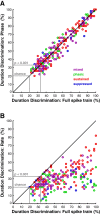Diverse cortical codes for scene segmentation in primate auditory cortex
- PMID: 25695655
- PMCID: PMC4416616
- DOI: 10.1152/jn.01054.2014
Diverse cortical codes for scene segmentation in primate auditory cortex
Abstract
The temporal coherence of amplitude fluctuations is a critical cue for segmentation of complex auditory scenes. The auditory system must accurately demarcate the onsets and offsets of acoustic signals. We explored how and how well the timing of onsets and offsets of gated tones are encoded by auditory cortical neurons in awake rhesus macaques. Temporal features of this representation were isolated by presenting otherwise identical pure tones of differing durations. Cortical response patterns were diverse, including selective encoding of onset and offset transients, tonic firing, and sustained suppression. Spike train classification methods revealed that many neurons robustly encoded tone duration despite substantial diversity in the encoding process. Excellent discrimination performance was achieved by neurons whose responses were primarily phasic at tone offset and by those that responded robustly while the tone persisted. Although diverse cortical response patterns converged on effective duration discrimination, this diversity significantly constrained the utility of decoding models referenced to a spiking pattern averaged across all responses or averaged within the same response category. Using maximum likelihood-based decoding models, we demonstrated that the spike train recorded in a single trial could support direct estimation of stimulus onset and offset. Comparisons between different decoding models established the substantial contribution of bursts of activity at sound onset and offset to demarcating the temporal boundaries of gated tones. Our results indicate that relatively few neurons suffice to provide temporally precise estimates of such auditory "edges," particularly for models that assume and exploit the heterogeneity of neural responses in awake cortex.
Keywords: cortex; decoding; encoding; primate; scene analysis.
Figures








Similar articles
-
Encoding frequency contrast in primate auditory cortex.J Neurophysiol. 2014 Jun 1;111(11):2244-63. doi: 10.1152/jn.00878.2013. Epub 2014 Mar 5. J Neurophysiol. 2014. PMID: 24598525 Free PMC article.
-
Temporally precise population coding of dynamic sounds by auditory cortex.J Neurophysiol. 2021 Jul 1;126(1):148-169. doi: 10.1152/jn.00709.2020. Epub 2021 Jun 2. J Neurophysiol. 2021. PMID: 34077273 Free PMC article.
-
Information content of auditory cortical responses to time-varying acoustic stimuli.J Neurophysiol. 2004 Jan;91(1):301-13. doi: 10.1152/jn.00022.2003. Epub 2003 Oct 1. J Neurophysiol. 2004. PMID: 14523081
-
Representations in auditory cortex.Curr Opin Neurobiol. 2009 Aug;19(4):430-3. doi: 10.1016/j.conb.2009.07.009. Epub 2009 Aug 10. Curr Opin Neurobiol. 2009. PMID: 19674890 Free PMC article. Review.
-
Spatial and temporal processing of single auditory cortical neurons and populations of neurons in the macaque monkey.Hear Res. 2011 Jan;271(1-2):115-22. doi: 10.1016/j.heares.2010.03.084. Epub 2010 Apr 27. Hear Res. 2011. PMID: 20430079 Free PMC article. Review.
Cited by
-
Spectral and spatial tuning of onset and offset response functions in auditory cortical fields A1 and CL of rhesus macaques.J Neurophysiol. 2017 Mar 1;117(3):966-986. doi: 10.1152/jn.00534.2016. Epub 2016 Dec 7. J Neurophysiol. 2017. PMID: 27927783 Free PMC article.
-
Rate, not selectivity, determines neuronal population coding accuracy in auditory cortex.PLoS Biol. 2017 Nov 1;15(11):e2002459. doi: 10.1371/journal.pbio.2002459. eCollection 2017 Nov. PLoS Biol. 2017. PMID: 29091725 Free PMC article.
-
Temporal Encoding is Required for Categorization, But Not Discrimination.Cereb Cortex. 2021 May 10;31(6):2886-2897. doi: 10.1093/cercor/bhaa396. Cereb Cortex. 2021. PMID: 33429423 Free PMC article.
-
A Hierarchy of Time Scales for Discriminating and Classifying the Temporal Shape of Sound in Three Auditory Cortical Fields.J Neurosci. 2018 Aug 1;38(31):6967-6982. doi: 10.1523/JNEUROSCI.2871-17.2018. Epub 2018 Jun 28. J Neurosci. 2018. PMID: 29954851 Free PMC article.
-
Age-related changes in sound onset and offset intensity coding in auditory cortical fields A1 and CL of rhesus macaques.J Neurophysiol. 2020 Mar 1;123(3):1015-1025. doi: 10.1152/jn.00373.2019. Epub 2020 Jan 29. J Neurophysiol. 2020. PMID: 31995426 Free PMC article.
References
Publication types
MeSH terms
Grants and funding
LinkOut - more resources
Full Text Sources
Other Literature Sources

